It’s essentially a no-brainer:
Whether you’re just starting an eCommerce business or you’re already an established online seller, the higher your conversion rates, the better off your business will likely be.
In a perfect world, your process of generating business from new and long-time customers alike would run like clockwork:
- They visit your site
- Then, they find products they like and add them to their cart
- Finally, they follow through with their purchase without hesitation
It sounds like a dream, doesn’t it?
In fact, the vast majority of your site’s visitors are going to leave without doing so; according to SmartInsights, the average conversion rates of eCommerce stores across industries through Q2 2018 was a mere 2.86%.
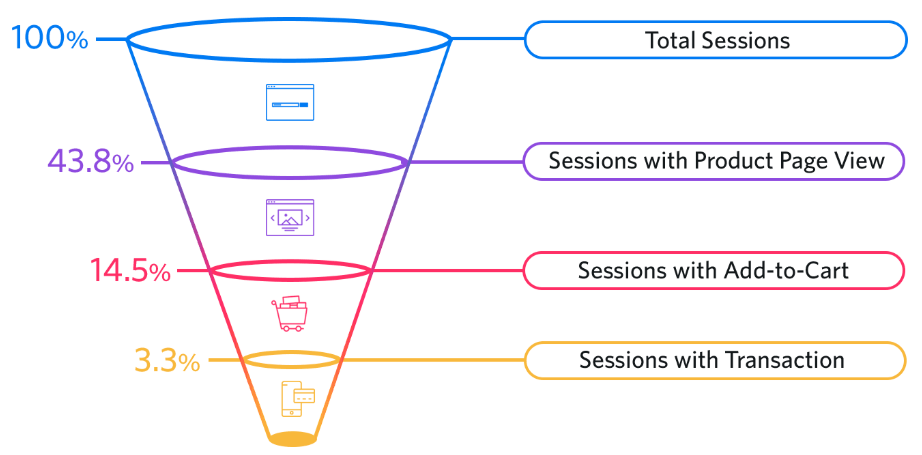
In this article, we’re going to discuss a number of high-level approaches to optimizing your eCommerce website. Therefore, it’s more likely your visitors will end up converting into paying customers. As we go through each tactic, we’ll also provide a variety of examples of brands “doing it right,” as well.
However, before we dive into a discussion of these strategies and tips, we need to understand the reasons. Like why an individual might decide to leave your eCommerce site empty-handed in the first place.
Why eCommerce Shoppers Don’t Convert
Realistically speaking, there are many reasons why consumers choose not to make a purchase at a given point in time. For example:
- Your Site Makes a Bad First Impression
- You Don’t Know Who You’re Selling To
- Your Site Isn’t Optimized
- You’re Ignoring Mobile Users
- Nobody Loves (or Understands) Your Product
- Product Images Are Poor
- Your Copy Isn’t Persuasive
- The Page Is Distracting
- The Call to Action Is Unclear
- Shoppers Don’t Trust You
- People Have to Pay for Shipping
- Check out Is Difficult
- You’re Not Using Exit Intent
- There’s No Re-marketing or Re-targeting Strategy
- …
Not only does having this understanding allow you to anticipate and avoid making these same mistakes. It also proves to you that making these mistakes doesn’t necessarily mean you’ve failed. As long as you understand why you made the mistake, and how to go about fixing it, your business will continue to improve on a daily basis.
How to increase your eCommerce conversion rate
Today, we’re going to provide some actionable tips and advice regarding what to do to start generating more conversions — even without increasing your visitor numbers.
Let’s dive in right away!
1. Apply persuasive design and content on your website/app
First of all, We want to begin by discussing the more overarching topic of site design in general.
Persuasive design
There is a principle:
If your site isn’t designed in a manner that keeps your visitors on the page — and moving forward with their transaction — none of the other tactics we’re about to discuss are going to make much of a difference.
That said, firstly, your site needs to be:
- Visually appealing
- Visually persuasive
The “appealing” part is pretty straightforward. Needless to say, the modern consumer is more likely to engage further with fancy websites/apps, such as:
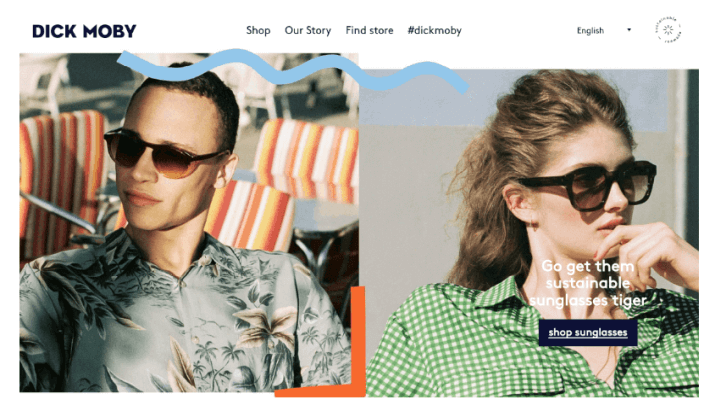
Than with this site:
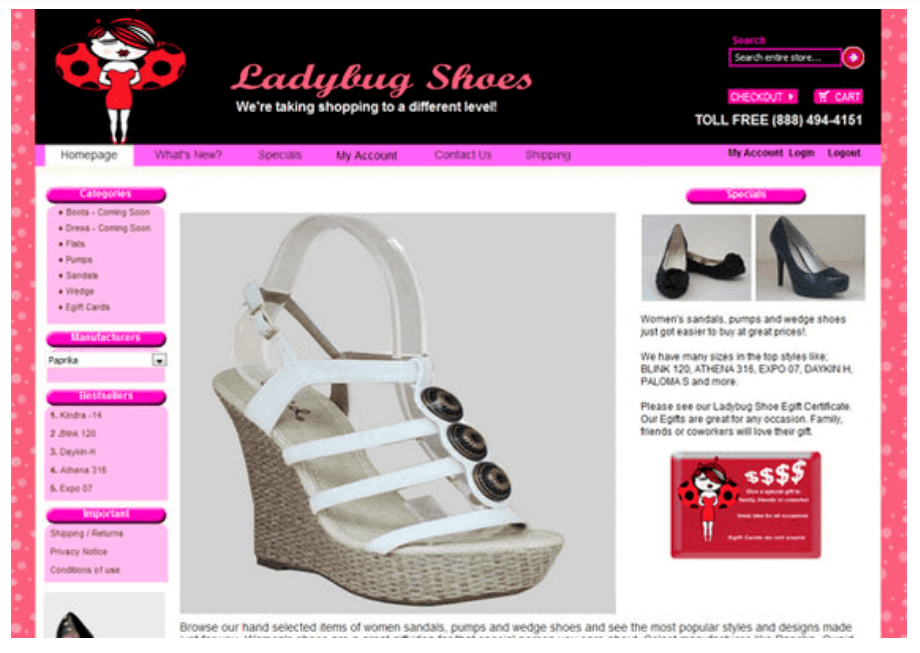
While we could certainly take a deeper dive into why the first example is just that much more appealing, let’s just say it has a certain je ne sais quoi that the latter clearly does not.
Visual persuasiveness, on the other hand, is a little more nuanced. Essentially, the goal is to pull your visitors’ eyes to a certain part of the page — typically the part which will allow them to move a step closer toward converting.
Take a look at Away’s homepage:
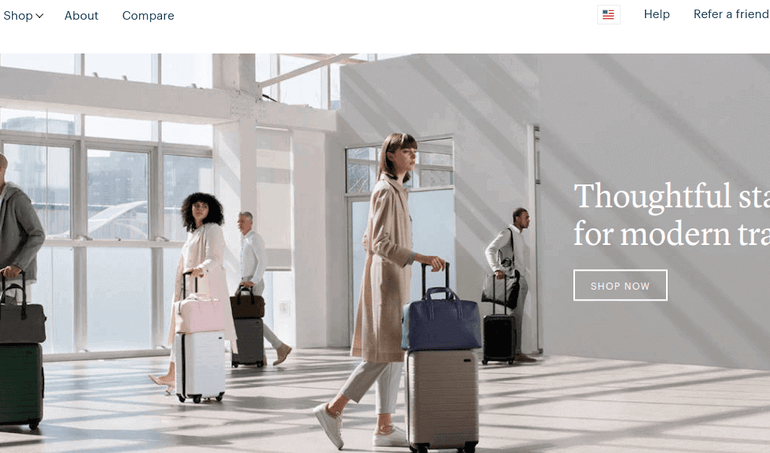
Typically, the visitor’s attention will be drawn to the following elements almost immediately — in the following order:
- The main image
- The inlaid text
- The call-to-action button below the inlaid text
While this homepage does provide a number of clickable options, it’s crystal clear what new visitors are “supposed” to do right from the get-go. Now that’s persuasive design.
Persuasive copy/content
The goal of persuasive copy is quite similar: “Keep your visitors engaged and moving forward with a transaction.”
Now, when we say “persuasive,” here, we don’t mean that your copy needs to be too salesy or anything like that. Rather, it all comes down to ensuring your brand’s “voice” shines through every single word on your website.
Take a look at the following example from PETSMART
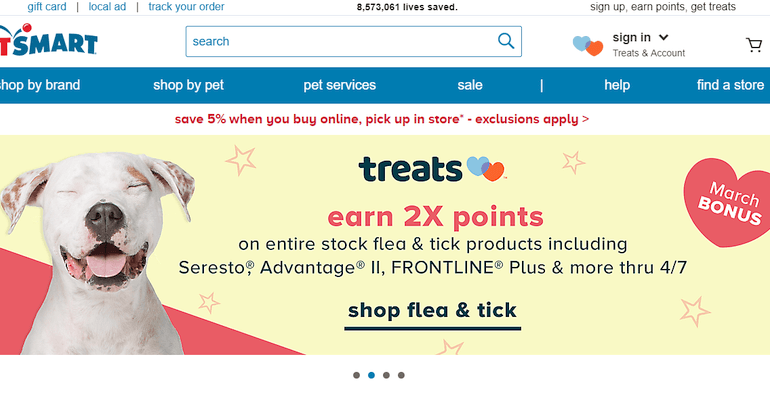
There’s no doubt about it: The copy on this product page was written by a fan of pets, for a pet lover. It basically screams, “Hey! We’re just like you, and we love this product — so we know you will too!”
Boom! Sold.
2. Make a simple and easy navigation
If you walked into a brick-and-mortar retail store that had its products strewn about haphazardly, you almost certainly would turn right around and walk out.
Well…the same goes for your eCommerce store:
If your visitors aren’t able to find what they’re looking for quite literally at the click of a button, they’re going to navigate away to a competitor’s site almost immediately.
Of course, the more products you offer, the more important this is. Take a look at this example from IKEA:
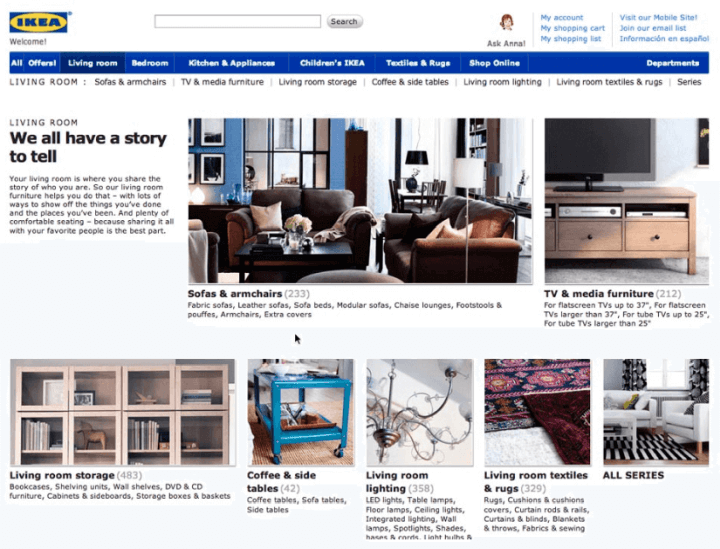
Using the navigation bar at the top of the screen, visitors are easily able to venture to the intermediary product category page they’re looking for. From there, they’ll be able to dig deeper into the specific products offered within each individual category.
Now, this is all well and good for those who are merely browsing your site for products they may like. For those who know exactly what they’re looking for, you need to provide a robust search solution.
While there are a number of factors to consider when optimizing your site’s search functionality, your main concern is, of course, in ensuring your visitors are presented with the most relevant products relating to their search term. As we’ll discuss in a bit, this is why your product pages need to be well-put together, complete with vital information presented in a way that matches your customers’ search queries.
3. Personalize
That said, there are two overarching ways to personalize your visitor’s experience:
- Providing dynamic content
- Providing pathways for your visitors to take
Essentially, tools for creating and delivering dynamic content allow you to present tailored content, offers, and product recommendations to your visitors. It based on factors such as their demographic and geographic data, their on-site behavior, and their history with your brand.
We recently talked about the best tool (AI and machine learning) to create a personalized experience for customers, so check out that post for a much deeper discussion on the topic of using AI and machine learning in eCommerce.
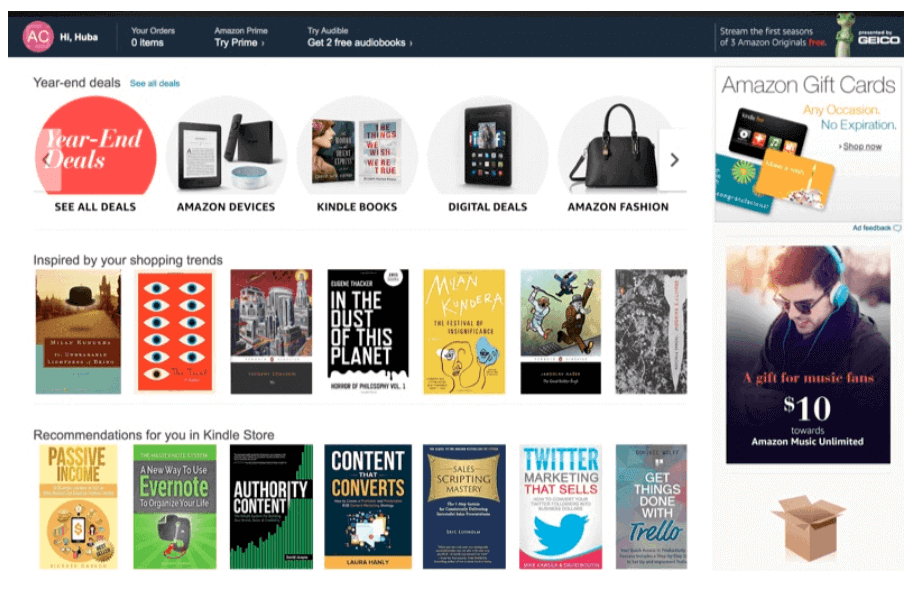
In terms of providing pathways for your visitor to choose from, you’ll want to consider the “types” of consumers you typically attract. Essentially, you’ll be pointing them to “collections” of products that relate to each other — but aren’t necessarily in the same product category.
4. Allow shopping via social media platforms
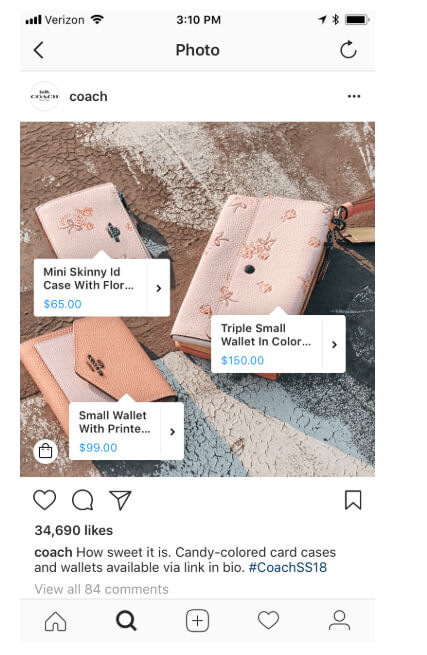
Your brand almost certainly has at least some type of presence on the various social media platforms out there, right?
We’ve mentioned Shoppable Tags on Instagram as an impressive mCommerce trend in 2021 in an article before.
Simply advertising and/or creating an organic presence on channels such as Facebook and Instagram aren’t exactly anything new. But more and more eCommerce companies are turning to these channels to actually sell their products directly to their followers.
This is an especially lucrative venture if the products you offer fall in line with the type of content that’s typically shared on Instagram. Therefore, if you’re in the clothing, fashion, or culinary industries — or really any industry that relies heavily on visual presentation — you should be looking to make your Instagram profile shoppable.
5. Provide multiple discount options
Perhaps the only better than a discount, in the eyes of the consumer, is the ability to customize the discount they’re about to receive.
On the other hand, it’s quite disappointing for a consumer when they receive a coupon or offer in their email, load up their virtual shopping cart…and then realize the offer doesn’t apply to their purchases.
That said, it can be beneficial to provide your customers with at least a bit of control over when and how they use a specific discount offer. Not only does this add a bit of personalization to their experience (as we discussed earlier), but it also incentivizes them to “experiment” — potentially leading them to make additional purchases they hadn’t originally anticipated.
Target provides a prime example of this on the company’s main site:
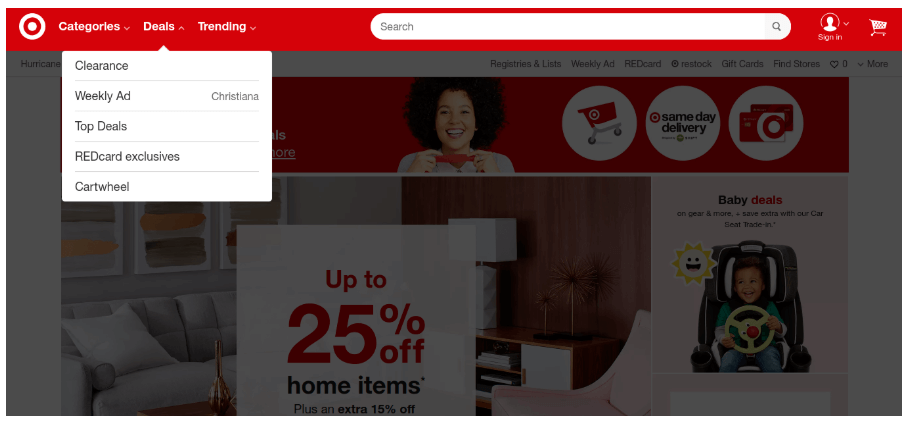
Here, Target provides five different ways for its customers to save. The most intriguing, for our purposes, are the sections on REDcard exclusives and Cartwheel deals; in these sections, the loyal Target customer is presented with deals that only those with a membership are privy to.
Another prime example comes from office supply retailer Quill. Basically, Quill allows its customers to collect electronic coupons in a virtual “clipboard,” and experiment with different ways to apply them in order to save cash.
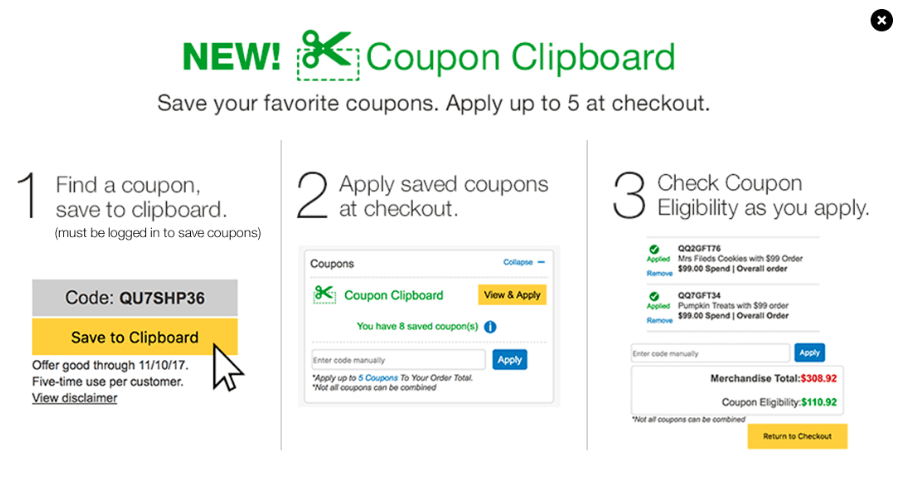
Not only does this put the customer in the driver’s seat in terms of discovering the optimal combination of coupon usage, but it also adds transparency to the process: through its Coupon Clipboard, Quill makes it very easy to tell which coupons can be applied at a given time, so that customers are never caught off-guard and left disappointed.
6. Showcase social proof
In terms of increasing conversion rates, social proof is huge.
According to a study conducted by Nielsen, 84% of consumers trust recommendations from friends, family members, and peers over any other type of marketing or advertising content.
Case in point, Consumerist found that 70% of online shoppers check out product reviews before making a purchase. Looking at this from a different perspective, of all the people who go on to make a purchase, 70% of them are impacted by product reviews in some way or another.
It’s also worth mentioning that positive social proof typically leads to an increase not just in conversion rate, but also average order value and retention as well.
Such social proof can take a variety of forms, including product reviews:
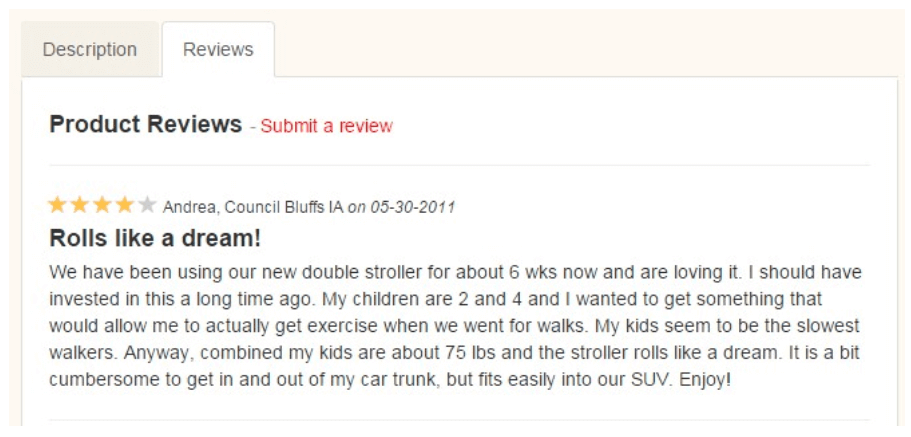
Expert testimonials:
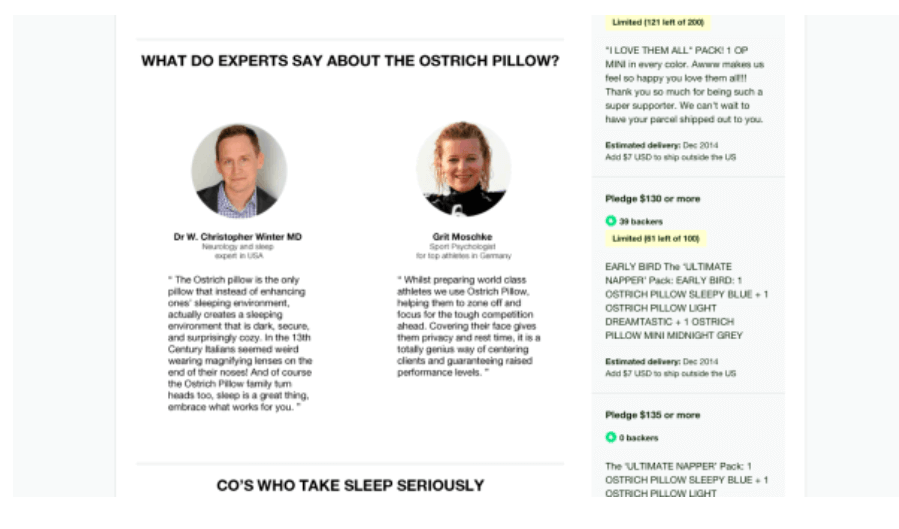
And celebrity endorsements:

You also don’t want to ignore the propensity of individuals to “go with the herd,” either. That said, simply showcasing your best-selling or hot-ticket items can also act as social proof. It’s like to show the fact that other people are buying it.
7. Allow for guest checkout
Scroll back up for a moment and review that chart once more.
Back? Did you notice the number two reason consumers abandon their carts?
You guessed it: The site in question required that they register an account with the company.
While, ideally, every single individual who makes a purchase from your site will want to continue doing business with your company in the future, it’s simply not going to happen. Some might simply want to make a single purchase and be on their way; others may be purchasing a gift for their friend, and have no interest in your products themselves; still others just won’t want to receive yet another newsletter in their inbox on a weekly basis.
Whatever the case may be, it’s in your best interest to allow those who wish to check out as a guest to simply do so.
However, you certainly can — and should — provide multiple chances for them to register with your company, both before and after they’ve made a purchase. When providing these chances, make sure you’re clear about what’s in it for them.
Here, Sears promises a faster checkout process and a number of benefits for members of the company’s loyalty program:
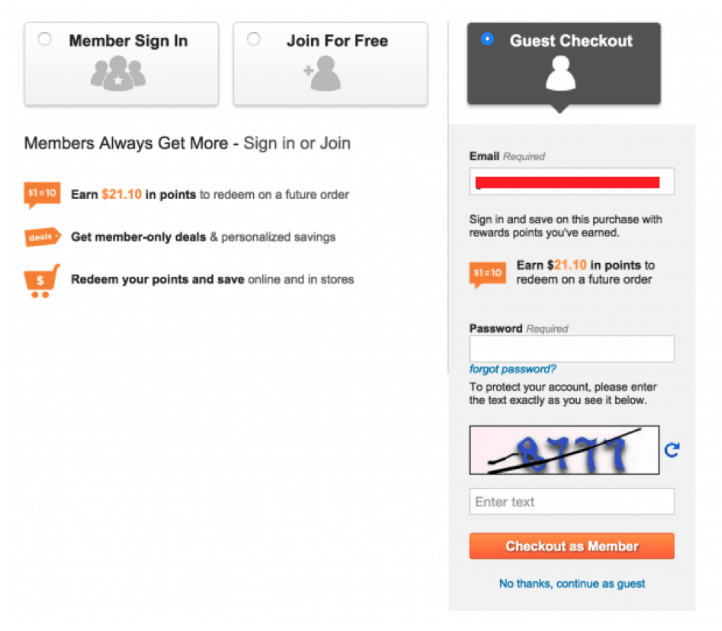
8. Offer Multiple Payment and Delivery Options
As we mentioned in the previous section, the only time you want to add steps to the checkout process is when providing options your customers will appreciate.
As you surely know, there are a ton of ways the modern consumer can make an online payment. From PayPal to Apple Pay – and many others – credit cards are no longer the guaranteed mode of payment by today’s standards. That said, you’ll want to look into which payment methods your target audience typically prefers, and be absolutely certain that you’re able to cater to these needs.
You’ll also want to provide a number of delivery options to your customers, as well. Typically, your options should offer a trade-off of sorts between price and convenience; that is, you’ll want your customers to be able to pay more for rush delivery, or to receive cheap (or free) shipping in exchange for a longer delivery period.
Again:
By this point in the process, you’ve all but sealed the deal with your new customer. You don’t want to lose them because they logistically can’t pay for or receive their order.
9. Re-engage Cart Abandoners
Unfortunately, you’re still going to face instances in which a potential customer fills up their virtual shopping cart…then suddenly navigates away from your site without finalizing their purchase.
When this happens, you basically have two options:
- Say “oh well” and move on
- Do everything you can to re-engage your potential customer
(Obviously, you know which side of the fence we’re on.)
As we mentioned earlier in this article, there is any number of reasons for a consumer to bounce from your page without making a purchase. Needless to say, a discussion on how to get these individuals back on track toward converting could be an article in and of itself.
From a high-level perspective, though, re-engaging cart abandoners involves:
- Understanding why they left in the first place – and working to mitigate the issue
- Providing incentives via exit-intent popups, remarketing campaigns, and email content
- Reinforcing the value of your products to your customers, via the above methods
A lost customer is only lost if you let them slip away. But, with the right offer, a one-time cart abandoner could end up becoming a loyal brand fanatic.
Find your conversion killer, and fix it
To wrap up, it’s important to recognize that every eCommerce business is different — as are its customers.
That said, there are any number of reasons that your conversion rate might not be as high as you’d like — or as it could potentially be.
While the tips we discussed throughout this article should be enough to get you moving in the right direction, you should always be looking for ways to improve your site, as well as your backend processes. To do so, you’ll want to stay in constant contact with your team, as well as with your customers — both those who are happy with the services you provide and those who aren’t quite as satisfied.
Once you’ve pinpointed an issue that may be causing a drop in conversions, take the time to fix it up — while leaving everything else as is. Once you’ve resolved the issue, you can move onto the next area of improvement — and keep on going until you’ve created a well-oiled, conversion-generating machine.

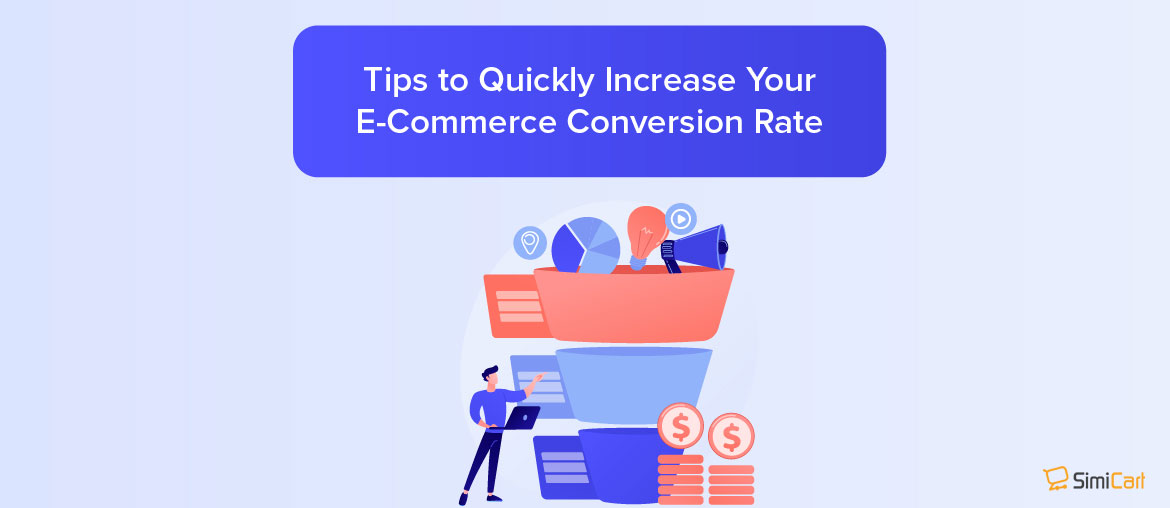



Thank you for your appreciation, Priya. We’re glad that you enjoyed reading our resource.
If you find it useful, we would like to keep you updated with more posts like this in the future. You can allow us to do that by subscribing to our blog at simicart.com or follow us on our social channels.
Thank you for this informative article. I was looking for such type of information as I am new in the eCommerce business and really desperate to know the tips, tricks and hacks that can help me in improving the conversion rate of my website. I have also explored websites in order to get the information. Keeping posting such type of articles as it will help lots of readers to understand how to boost their e-commerce conversion rate.
Hey Mia! Great article, definitely agree with the tips (especially the latter half as it pertains to facilitating the buyer’s journey).
Would love to get in touch to talk more about this if possible!
In order to increase the conversion rate of your website, you can create a good user experience, make it easy to navigate, offer valuable content, increase the speed of your website, etc. To increase the conversion rates of your website, you can take the help of https://www.alakmalak.com/?UTM-andrew-aug/ They have skillful and experienced professionals who have helped me multiple times and can do the same for you.